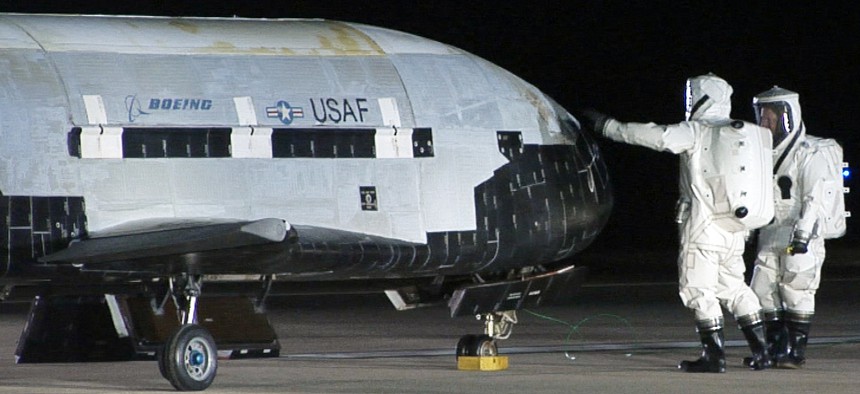
Air Force Space Command
The Air Force's Secret Space Drone Is Headed Back To Orbit
Less than five years ago, the X-37B became the first U.S. spacecraft to land on a runway autonomously. Now, as before, few know what its mission actually is.
The Air Force is scheduled to conduct its fourth launch of the X-37B spacecraft—a flying robot that looks like a shrunken down version of the Space Shuttle—and we still don’t know exactly what it will do up there in orbit.
Built by Boeing, the X-37B has flown just three times. After its first flight, in 2010, it became the first US spacecraft to land on a runway autonomously. The next two missions, there were major increases in the time spent flying; the last time it was launched, in 2012, it stayed in space for almost two years, landing in October 2014.
Those long stays have raised lots of questions about what the craft is doing up there. Some have speculated that it is intended to spy on Chinese satellites or China’s space station; others have suggested that it is designed to test earth-surveillance tools—despite the fact that the Air Force isn’t responsible for the US government’s spying efforts. (However, for your paranoia purposes, the National Reconaissance Office, which is responsible for those eyes in the sky, will launch (pdf) nine experimental cubesats alongside the X-37B.)
The (more boring) experts suggest that the X-37B is likely testing the effects of long-time orbital exposure—including solar radiation and microasteroids—on new technology that might be used in future space planes or satellites. With the new launch, we can expect amateur astronomers to continue their efforts to track the craft and speculate anew on what it might be doing up there; official sources have declined to discuss the classified program.
One exception to the no-comment rule was a was a 60 Minutes interview with general John Hyten, the head of Air Force Space Command, who told the news program that the craft is “really for cool things,” emphasizing its ability to bring test payloads back to earth—but he declined to specify what those cool things entail.
Given the increasing importance of space technology to life on earth, and Russia and China’s testing of autonomous spacecraft maneuvers in recent years, it’s no surprise that the US Air Force wants to develop the technology for its own reusable space craft. The question remains whether it will develop a larger version to transport humans, which some speculated might be the case after the headquarters of the project moved from Vandenburg Air Force Base in California to old Space Shuttle hangars at Cape Canaveral, or if the project will continue as an entirely autonomous effort.
The other lagging question is who will launch the X-37B the next time it flies. Today’s lift will be provided by United Launch Alliance, the Boeing-Lockheed Martin joint venture that dominates US national security launches. But by the time the X-37B comes back to Earth, Elon Musk’s SpaceX is expected to be certified and competing for top-secret gigs like these.
NEXT STORY: The Army Is Shopping for Cyber Weapons




